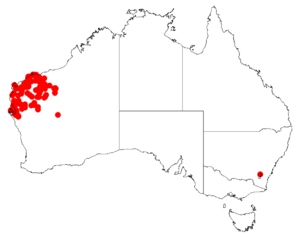Snakewood facts for kids
Quick facts for kids Snakewood |
|
|---|---|
 |
|
| Scientific classification | |
| Genus: |
Acacia
|
| Species: |
xiphophylla
|
 |
|
| Occurrence data from AVH | |
| Synonyms | |
|
|
The Snakewood tree, also called Acacia xiphophylla, is a special type of tree. It belongs to the Fabaceae family, which includes peas and beans. This tree is found only in Western Australia, meaning it is endemic there.
Different Aboriginal groups have their own names for Snakewood. The Martuthunira, Ngarluma, and Yindjibarndi peoples call it marrawa. The Kariyarra people know it as puluru, and the Jiwarli people call it pukarti.
What Does Snakewood Look Like?
Snakewood grows as a bushy tree or a large shrub. It often has two or three main trunks that look twisted. This plant can grow to be about 1.5 to 7 meters tall. It can also spread out very wide, up to 8 meters across!
Its main branches are usually twisted and spread out far. The smaller branches are smooth or have very fine hairs. Like most Acacia plants, Snakewood has phyllodes instead of true leaves. Phyllodes are flattened leaf stems that act like leaves.
These phyllodes are a pretty bluish-grey color. They are shaped like an oval or a strap, getting narrower at the tip. They can be straight or slightly curved, measuring about 5 to 12.5 centimeters long and 3.5 to 16 millimeters wide. They have many faint lines running along them.
Snakewood flowers soon after it rains. You can see its flowers between January and May, and again in August and September. The flowers grow in small, cylinder-shaped spikes that are 2.5 to 5.5 centimeters long. These spikes are about 5 to 7 millimeters wide and have light golden flowers packed loosely together.
After the flowers, seed pods grow. These pods are long and straight or slightly curved. They are raised over the seeds inside. The pods are tough and woody, measuring about 8 to 20 centimeters long and 7 to 18 millimeters wide. Inside, there are dull brown, oval-shaped seeds that are 6 to 10 millimeters long.
Snakewood is a slow-growing tree that lives for a long time. It only grows new plants from its seeds. It does not grow new shoots from its roots.
How Snakewood Got Its Name
Scientists give every plant a unique name. The Snakewood tree was first officially described in 1904 by a scientist named Georg August Pritzel. He included it in a big book about plants from Western Australia.
Later, in 2003, another scientist named Leslie Pedley gave it a different scientific name, Racosperma xiphophyllum. But in 2006, it was moved back to the Acacia group.
The second part of its scientific name, xiphophylla, comes from two Greek words. Xiphos means sword, and phyllon means leaf. This name describes the sword-like shape of the plant's phyllodes.
Snakewood looks a bit like other Acacia species, such as Acacia intorta and Acacia eremaea. Scientists think it is closely related to the Acacia hamersleyensis.
Where Does Snakewood Grow?
Snakewood trees grow in salty, dry areas of Western Australia. You can find them in the Gascoyne River and Ashburton river areas. These places are east and north of a town called Carnarvon.
It grows in the Gascoyne and Pilbara regions. You can spot Snakewood on flat plains, rocky clay areas, and in stony creek beds. It often grows as part of Acacia shrublands or low woodlands. Sometimes, Snakewood trees are the most common plants in these areas.

